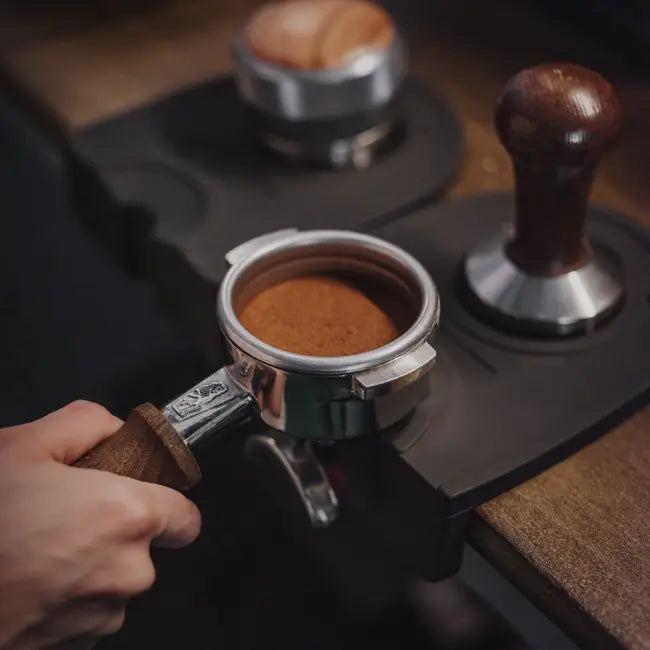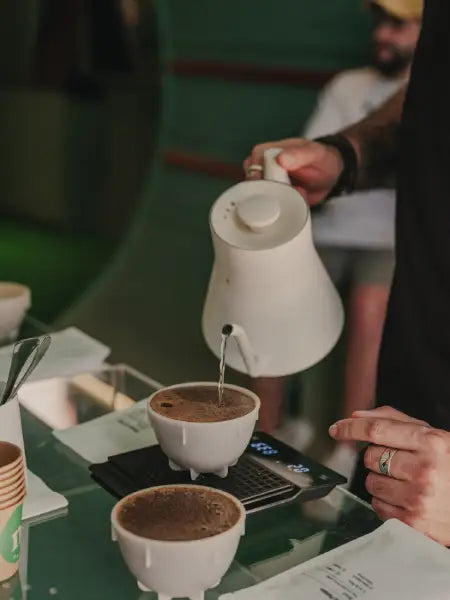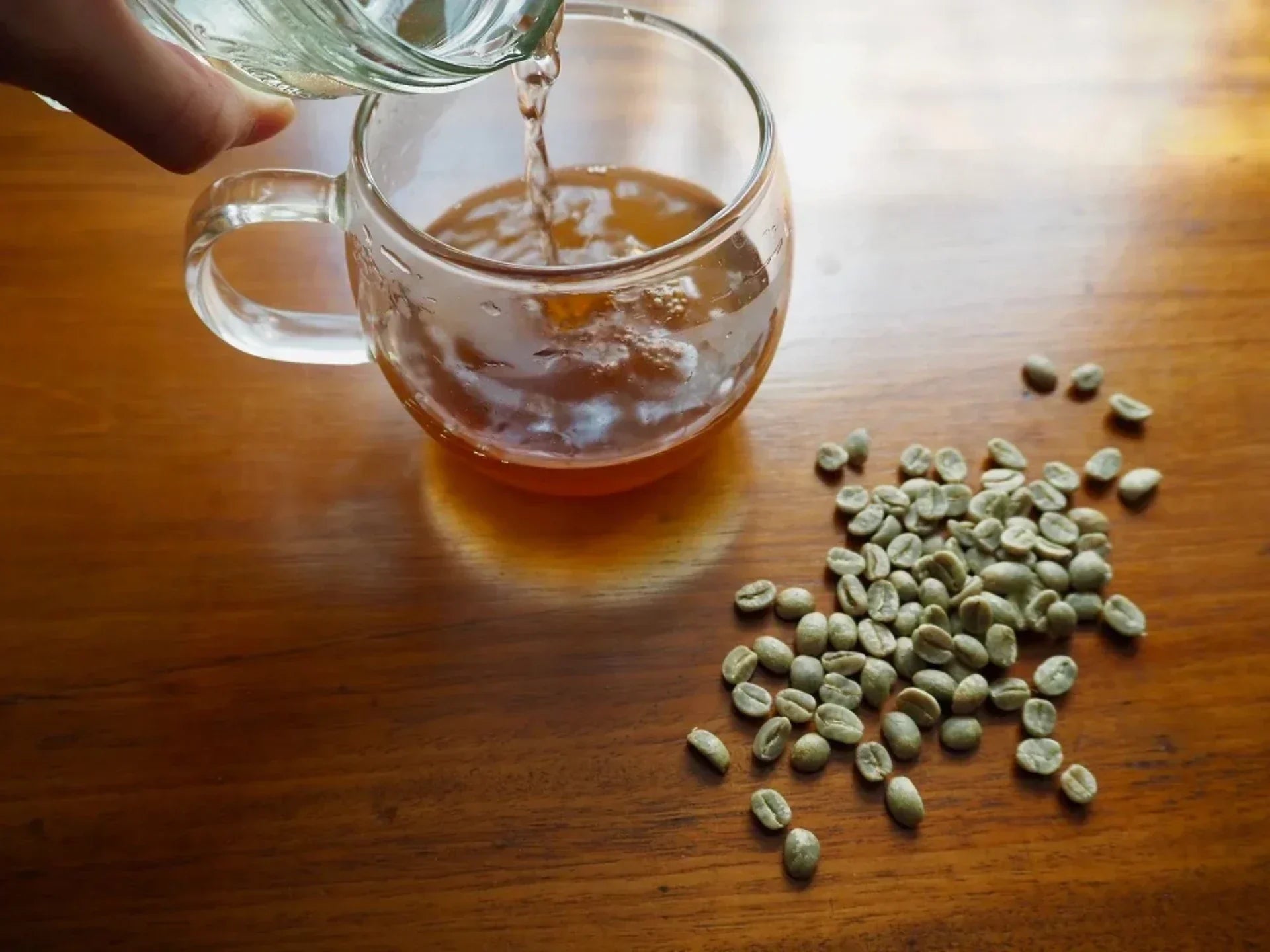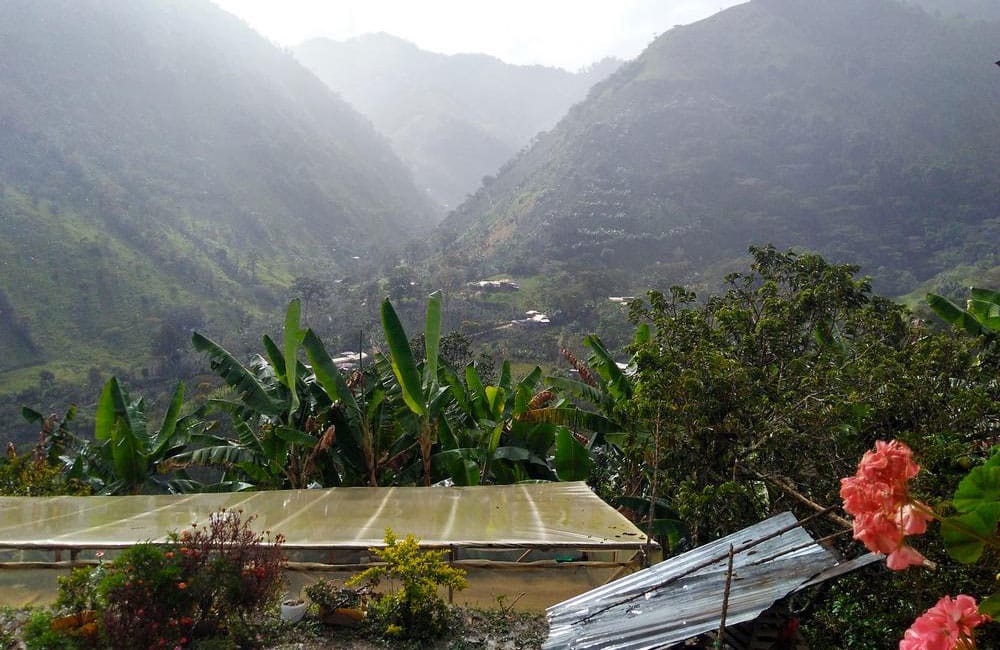El Poema de Gilgamesh, cuya composición se data alrededor del 2500 a. C, es la narración épica más antigua y uno de los primeros ejemplos de ficción literaria. En una de sus partes, el héroe, Gilgamesh, se sumerge en las profundidades del Golfo Pérsico para buscar la “flor de la inmortalidad”. Esta flor de la inmortalidad son las perlas que se encuentran en el interior de las ostras.
Con el café pasa algo similar. Cada semilla es como un perla que se esconde dentro de la baya; y en el interior de cada semilla un horizonte de experiencias gustativas y fisiológicas cuando la cafeína estimula nuestro sistema nervioso. Para conseguir el tesoro que esconde cada grano de café hemos de cultivar las bayas, obtener y procesar las semillas y luego realizar la extracción. Y para una extracción correcta hemos de moler el café. Para esto necesitaremos un molinillo de café.
Los molinillos de café son una herramienta indispensable si queremos obtener la flor de la inmortalidad que esconde en su interior cada grano de café; aunque esa inmortalidad sea pasajera.
¿Por qué necesitamos un molinillo de café?

Esta pregunta puede parecer obvia, pero en realidad no lo es tanto. Podríamos reformularla de la siguiente manera: ¿por qué necesitamos un molinillo de café cuando podemos comprar el café molido?
La respuesta es sencilla. Necesitamos un molinillo de café si queremos mantener las cualidades organolépticas del café intactas hasta la extracción.
El café es una sustancia orgánica y como todas ellas sujeta a un proceso de oxidación por efecto del contacto con el oxígeno (en este post explicamos en detalle el proceso de oxidación del café y cómo ralentizarlo). Cuanto mayor es el área de contacto con el oxígeno mayor será el grado de oxidación. Por lo tanto, al mantenerlo en grano estamos reduciendo el área de contacto y retrasando la oxidación.
El proceso de oxidación del café

El café comienza a oxidarse desde el mismo momento en el que las bayas son separadas de los cafetos. Pero mientras el café está en verde los compuestos químicos naturales de este no han sido alterados y la oxidación es menor. Una vez el café ha sido tostado, el calor hace que estos químicos naturales se alteren y liberen gases. Esto nos da la bebida que tanto nos gusta, pero también hace que el proceso se acelere.
Por esta razón es importante mantener el café en grano hasta justo antes de prepararlo. Al estar en grano, el café tiene menor superficie de contacto con el oxígeno que si estuviese molido. Al tener menor superficie la oxidación también es menor, y, por tanto, hay menor pérdida de cualidades gustativas.
Además de mantener el café en grano, otra indicación importante para ralentizar la oxidación del café es un embolsado correcto. Como hemos dicho, cuando se tuesta el café libera CO2 a consecuencia de una reacción química natural. Estos gases continúan emergiendo una vez finalizado el tueste. Un embolsado correcto es en una bolsa cerrada herméticamente, pero con una válvula unidireccional. De esta forma, los gases que continúa liberando el café pueden expulsar el oxígeno restante de la bolsa por la válvula y ralentizar la oxidación.
¿Qué es un molinillo de café manual?
Otra pregunta que puede parecer obvia, pero que no lo es tanto. Un molinillo de café manual es una herramienta que nos permite reducir el tamaño de las semillas de café a una medida más pequeña para que el agua pueda extraer todas sus propiedades.
Hasta ahí todo bien, pero por esta definición cualquier utensilio que nos de los mismos resultados podría considerarse un molinillo. Y en cierta manera es así. Algunos hemos llegado a moler café con dos piedras de río a falta de uno.
Pero no todos los molinillos son iguales.
 Dos piedras de río usadas como molinillo.
Dos piedras de río usadas como molinillo.
¿Molinillo de café manual o eléctrico?
Cuando nos referimos a un molinillo de café manual hablamos de un utensilio diseñado para moler el café de forma manual. Estos dos datos son importantes: moler y de forma manual. Porque podríamos decir ¿y un molinillo eléctrico? Podría ser una opción, pero solo si tienes suficiente presupuesto.
Los molinillos eléctricos de uso cotidiano no molerán el café, si no que lo triturarán y, además, dado que funcionan con un motor, pueden calentar el café. Hemos de evitar ambas cosas. Al triturarlo, las partículas resultantes serán de tamaños muy variados (veremos más adelante porque esto no es bueno, pero tiene que ver con la teoría de la extracción) y el calor puede hacer que pierda cualidades.
Los molinillos manuales -en especial aquellos diseñados para moler café- suelen tener muelas cónicas que ayudan a una molienda más uniforme. Y, al ser manuales, tú eres el motor por lo que no se calienta (aunque esto cree en ocasiones una paradoja curiosa: necesitas cafeína para moler, pero necesitas moler para obtener cafeína. Nosotros la hemos resuelto y te proponemos una solución más adelante).
 Diferentes métodos de preparar café
Diferentes métodos de preparar café
Teoría de la extracción
Ahora centrémonos brevemente en la teoría de la extracción. La teoría de la extracción se refiere a cómo realizamos la extracción de los solubles del café cuando entran en contacto con el agua. También a la cantidad de solubles que dicha extracción debe contener. Obviamente, para que esto suceda, es necesarios moler el café.
La bebida del café es el resultado de extraer con agua las partículas solubles que contiene cada grano de café. El café tiene alrededor de un 28% de materia orgánica e inorgánica que, un vez tostado y molido, se disuelve en el agua. El 72% restante es celulosa de la fibra de la semilla y que no se disolverá en condiciones normales (y que no queremos que se disuelva).
Este 28% se compone de unos 800-1000 saborizantes y aromatizantes naturales. Estos diferentes compuestos, que varían de café a café, es lo que da tanta complejidad a cada taza y lo que diferencia a un café de otro.
De este 28% de solubles, para una extracción correcta, hemos de conseguir que entre el 18% y el 22% se disuelvan correctamente en el agua. Si es más que esto, podemos terminar con una taza sobre extraída y con notas amargas. Si es menos de 18% podemos acabar con una taza poco extraída y no obtener todas las notas organolépticas posibles.
La vanguardia del café de especialidad está experimentando hasta con un 27% de extracción, pero para conseguir resultados aceptables con este porcentaje hemos de tener una idea muy clara de lo que estamos haciendo y queremos conseguir.
Teoría de la extracción y distribución de la molienda

Es evidente que para conseguir estos porcentajes el café debe de estar molido. Si estuviese en grano esto no sería posible puesto que el agua no penetraría lo suficiente en el café como para realizar una extracción correcta.
Al moler el café lo que buscamos es que todas las partículas molidas tengan un tamaño lo más uniforme posible. Si no fuese así, si algunas partículas molidas fuesen muy grandes y otras muy pequeñas, habría partes sobre extraídas y otras pocas extraídas. Esto daría como resultado una taza con notas amargas y gustativamente pobre al mismo tiempo.
La forma de comprobar que nuestra molienda sea correcta es midiendo las partículas de café molido. Estas variarán de un micrón a mil quinientos micrones. Pero esto son los extremos, la mayoría estará entre 100 y 800 micrones. Nuestro objetivo al moler es que todas las partículas se encuentren entre estos márgenes y sean los más uniforme posibles. Esta es la función de un buen molinillo de café manual. También puede conseguirse con uno eléctrico, pero probablemente nuestro desembolso sea mucho mayor.
¿Cómo afecta el tamaño de la molienda a la extracción de café?
En este vídeo (que está en inglés) se explica de una forma muy clara como el diferente tamaño de las partículas afecta a la extracción.
https://www.youtube.com/watch?v=kI3zOwFG9mg
En el vídeo se realiza un experimento para ver cómo penetra el agua en las partículas de café dependiendo de su tamaño.
En primer lugar, se muele el café y con varios coladores se separan las partículas molidas por micrones:
Las de 0 a 250 micrones
Las de 250 a 500 micrones
Las mayores de 500 micrones
Luego se realiza una extracción por inmersión, se deja reposar el café y se realizan mediciones en fracciones de tiempo para ver el porcentaje disuelto.
El resultado es que en las partículas de 0 a 500 micrones se puede realizar una extracción completa de todos los solubles con un tiempo adecuado. Pero en las mayores de 500 el agua no llega a penetrar por completo, por lo que no se realiza una extracción completa. La siguiente imagen lo ilustra de forma fácil.
En la imagen, el color marrón oscuro representa partículas de café y el marrón claro hasta dónde penetra el agua. Como vemos, en las partículas de mayor tamaño (>500 micrones) el café no penetra hasta el centro y por lo tanto no se realiza una extracción completa.
¿Cómo usar un molinillo de café?
Cualquier molinillo de café que se precie tendrá una forma de ajustar el tamaño de la molienda, ya sea un molinillo manual o eléctrico.
Esto es lo más importante a la hora de moler el café: que ajustemos la molienda al método de extracción que vayamos a utilizar y que la molienda sea lo más homogénea posible.
Y esto es lo que diferencia a un buen molinillo de café de un malo: ajustabilidad y homogeneidad de la molienda.
Para conseguir esto los molinillos que están diseñados para el café de especialidad suelen contar con muelas cónicas de cerámica o acero. También tendrán un mecanismo para ajustar el tamaño de la molienda. Todos los molinillos que te proponemos a continuación cuentan como mínimo con estas características, y otras que también te serán muy útiles.
Y, como primera referencia para una molienda correcta conforme al método de extracción, puedes seguir esta guía:
Espresso: molienda muy fina (casi como harina)
Mokka: molienda fina (como sal fina)
AeroPress: molienda media (un poco más grueso que sal fina)
V60: molienda media (un poco más grueso que sal fina)
Chemex: molienda media (un poco más grueso que sal fina)
Émbolo: molienda gruesa (como sal gruesa)
Los mejores molinillos de café del 2024
Te proponemos cuatro molinillos de café que cumplen todas las características que hemos descrito más arriba. Tres de ellos son manuales y uno eléctrico. Estos molinillos se encuentran en un rango de precios diferentes para que puedas elegir el que mejor se ajusta a tu presupuesto, pero todos te darán un resultado satisfactorio (¡los hemos probado!)
- Molinillo de café manual Comandante: este molinillo es la estrella de los manuales.
- Molinillo de café manual Timemore C2: una excelente relación calidad/precio
- Molinillo de café manual Hario Mini Mill: para cuando tu presupuesto es ajustado, pero sin sacrificar lo esencial
- Molinillo de café eléctrico Wilfa Svart Aroma Precision: lo mejor si quieres resolver la paradoja de ‘necesito cafeína para moler, pero necesito moler para obtener cafeína’.
Molinillo de café manual Comandante C40: la estrella de los molinillos manuales
Este molinillo ha sido diseñado para cumplir las más altas expectativas de todos los amantes del café de especialidad.
Cuenta con un avanzado diseño y material en sus muelas de fresas cónicas, fruto de la investigación de esta marca. Esto hace que la muelas no se desgasten con el paso del tiempo y mantengan la molienda uniforme uso tras uso.
Además, el resto de los componentes, tanto el cuerpo, como el eje y la manivela están hechos de acero inoxidable.
Los rodamientos son de micro bolas y están fabricados del mismo material que las muelas: acero inoxidable martensítico. Este acero tiene un alto contenido en nitrógeno que lo hace muy resistente.
El cuerpo tiene detalles de madera, tanto en la tapa como en el mango, procedente de robles de la Selva Negra.
El recipiente para el café vez molido está realizado en vidrio de alta resistencia.
Cuenta con un sistema de fácil ajuste para cualquier tipo de extracción, desde espresso hasta prensa francesa.
Este molinillo es elegante, útil y muy duradero. Es una inversión alta pero segura. Si no lo pierdes es probable que no necesites otro.
Molinillo de café Timemore C3: la mejor relación calidad/precio
Este molinillo es una incorporación reciente de una marca que está haciendo muy bien las cosas en el mundo del café.
Su base son muelas cónicas de acero inoxidable de 5 hojas. Esto asegura una molienda homogénea durante más tiempo.
El exterior está hecho de aluminio rugoso que lo hace muy resistente además de darle un estilo contemporáneo.
A diferencia del anterior, en el interior tiene algunos elementos, como el eje, que están hechos de plástico altamente resistente. Pero son elemento que están protegidos de golpes y que no corren riesgo de romperse.
Tiene una manivela de gran tamaño para facilitar la activación de las muelas y que tengas que hacer menor esfuerzo.
Es un molinillo bonito, que podrás desmontar y llevar fácilmente a cualquier lugar y que te asegura una molienda homogénea. Además, también se ajusta fácilmente.
Cumple con todas las características que le pediríamos a un molinillo de café de especialidad. Es una apuesta segura por un precio más económico y que no te defraudará ni en su uso ni en su durabilidad.
Molinillo de café Hario Mini Mill: un molinillo para todos
Este es el molinillo que recomendamos a todos los que se inician en el mundo del café de especialidad. Es bueno, es bonito y es barato.
Está construido alrededor de unas muelas cónicas de cerámica que aseguran una molienda homogénea durante más tiempo. Y esto es lo más importante en un molinillo.
Todo lo demás, menos la manivela y el eje que están hechos de aluminio, es de plástico. Pero esto no quiere decir que sea de poca calidad. Está bien diseñado y fabricado. Es bonito y se desmonta con facilidad para su transporte y limpieza. Y, por supuesto, la molienda es ajustable.
Entonces, ¿por qué su precio es mucho más bajo que los anteriores? Pues bien, porque a parte de las muelas, se ha economizado su coste con el resto de los materiales.
Y esto se nota. Hemos escuchado que tanto la parte que contiene el café en grano como donde cae cuando se muele, tienen tendencia a romperse si se sufren un golpe fuerte.
Pero por el precio que tiene nosotros no vemos que esto sea un inconveniente, sino algo esperable. Simplemente hay que tener más cuidado, porque también hemos tenido alguno que nos ha durado años.
Molinillo de café eléctrico Wilfa Uniform Grinder
La respuesta a nuestra paradoja. Aquella que decía “necesito cafeína para moler café, pero tengo que moler café para obtener cafeína”.
Con el Wilfa Uniform esa frase cobra más sentido que nunca, porque hablamos de un molinillo que convierte la rutina de moler en un pequeño ritual.
Si buscas un molinillo eléctrico para casa que combine precisión, diseño y facilidad de uso, este es el tuyo. Su motor de baja velocidad evita el sobrecalentamiento y mantiene intactos los aromas del café. Además, con sus muelas planas de acero inoxidable de 58 mm, consigue una molienda uniforme y consistente, perfecta tanto para espresso como para métodos de filtro.
Otro de sus puntos fuertes es la versatilidad: cuenta con 41 ajustes de molienda claramente marcados, lo que te permitirá experimentar hasta dar con el punto exacto para tu cafetera, desde un espresso fino hasta una prensa francesa más gruesa.
El Wilfa Uniform también suma innovación con una báscula digital integrada en la tapa del recipiente. De precisión milimétrica (0,1 g), incluye temporizador y pantalla LED, y puede conectarse por Bluetooth a una app que te da consejos y recetas. Un detalle que hace la experiencia todavía más completa.
En cuanto al diseño, es elegante y minimalista, fabricado en aluminio y acero para garantizar durabilidad y darle un aspecto premium que no desentona en ninguna cocina. Eso sí, no es precisamente pequeño: está pensado para quedarse en casa, no para llevarlo de viaje como ocurre con los molinillos manuales.
¿El precio? Es una inversión importante, pero totalmente coherente con lo que ofrece: precisión, comodidad y un nivel de calidad que se nota en cada taza. Si quieres un molinillo eléctrico fiable y avanzado, el Wilfa Uniform es la elección natural.
Choose your weapon
Ahora que ya sabes la importancia de una correcta molienda y conoces la diferencia entre un molinillo eléctrico y uno manual -y cuando elegir uno u otro- la pregunta es bien sencilla…
¿Con cuál te quedas?









